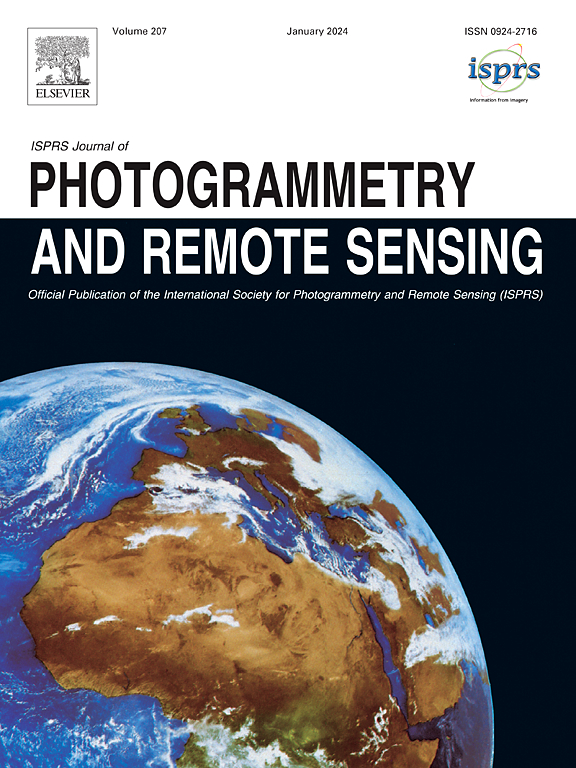基于对象级空间关系和多任务网络的有限标记样本挖掘场景理解框架
IF 10.6
1区 地球科学
Q1 GEOGRAPHY, PHYSICAL
ISPRS Journal of Photogrammetry and Remote Sensing
Pub Date : 2025-06-25
DOI:10.1016/j.isprsjprs.2025.06.024
引用次数: 0
摘要
准确圈定矿区对于监测非法采矿活动至关重要。目前,在大尺度、有限标注的样本场景中,矿区容易受到光谱特征相似的云层、农田、道路等目标的干扰,导致严重的误分类问题。针对这一问题,本文提出了一种基于对象级空间关系约束的矿区理解框架,模拟人类对遥感影像中矿区场景的理解方式。该框架首先构建了联合全视分割与关系预测多任务网络(PSRP-MNet),旨在实现矿区场景的高精度分割和明确对象级空间关系的获取;该网络包含明确的空间关系匹配模块、轻量级的分割头和多尺度可变形注意,实现了不同任务间深层次特征的全面融合,从而实现了多尺度语义信息的合理利用。空间关系匹配模块对矿区内存在的目标之间的空间位置关系进行显式建模和匹配,帮助模型从对象级目标的角度理解矿区。轻量化设计的分割头保持高性能,同时降低模型的复杂性和参数。随后,将空间关系与本文构建的先验对象级空间关系知识标准进行匹配,确定场景中的集成功能结构,进一步约束分割结果。空间关系的引导有助于PSRP-MNet在发生错误时纠正其预测,从而在有限的标记样本任务中获得出色的性能。选择两个足够大的场景作为研究区域,使用大约1000个图像样本进行训练。通过多组对比实验验证了该框架在有限标记样本任务中的有效性和跨区域泛化能力。结果表明,空间关系的引入和不同任务间的关联减少了PSRP-MNet的误差积累。本研究可望为矿产资源的定期监测提供参考。本文章由计算机程序翻译,如有差异,请以英文原文为准。
A mining scene understanding framework with limited labeled samples jointly driven by object-level spatial relationships and multi-task network
Accurately delineating mining areas is crucial for monitoring illegal mining activities. Currently, in large-scale and limited labeled sample scenes, mining areas are easily interfered by targets such as clouds, farmland, and roads with similar spectral characteristics, leading to serious misclassification issues. In response to this problem, this paper proposes a mining area understanding framework based on object-level spatial relation constraints, simulating the way that humans interpret mining scenes in remote sensing images. The framework first constructs a Multi-task Network for joint Panoptic Segmentation and Relation Prediction (PSRP-MNet), aiming to achieve high-precision segmentation of mining area scenes and acquisition of explicit object-level spatial relations. The network contained an explicit spatial relation matching module, a lightweight segmentation head, and multi-scale deformable attention to achieve a comprehensive fusion of deep-level features between different tasks and thus realize a rational utilization of multi-scale semantic information. The spatial relation matching module explicitly models and matches the spatial positional relations between targets existing in mining areas, helping the model understand mining areas from the perspective of object-level targets. The lightweight design of the segmentation head maintains high performance while reducing model complexity and parameters. Subsequently, the spatial relations were matched with the prior object-level spatial relation knowledge criteria constructed in this paper, determining the integrated functional structures in the scene to further constrain the segmentation results. The guidance of spatial relations helps PSRP-MNet correct its predictions when errors occur, leading to excellent performance in limited labeled sample tasks. Two sufficiently large scenes were selected as study areas, and approximately 1000 image samples were used for training. Multiple sets of comparative experiments were conducted to validate the framework’s effectiveness and cross-regional generalization ability in limited labeled sample tasks. It was observed that the introduction of spatial relations and the association between different tasks reduced the error accumulation of PSRP-MNet. This research is expected to provide a reference for the regular monitoring of mineral resources.
求助全文
通过发布文献求助,成功后即可免费获取论文全文。
去求助
来源期刊

ISPRS Journal of Photogrammetry and Remote Sensing
工程技术-成像科学与照相技术
CiteScore
21.00
自引率
6.30%
发文量
273
审稿时长
40 days
期刊介绍:
The ISPRS Journal of Photogrammetry and Remote Sensing (P&RS) serves as the official journal of the International Society for Photogrammetry and Remote Sensing (ISPRS). It acts as a platform for scientists and professionals worldwide who are involved in various disciplines that utilize photogrammetry, remote sensing, spatial information systems, computer vision, and related fields. The journal aims to facilitate communication and dissemination of advancements in these disciplines, while also acting as a comprehensive source of reference and archive.
P&RS endeavors to publish high-quality, peer-reviewed research papers that are preferably original and have not been published before. These papers can cover scientific/research, technological development, or application/practical aspects. Additionally, the journal welcomes papers that are based on presentations from ISPRS meetings, as long as they are considered significant contributions to the aforementioned fields.
In particular, P&RS encourages the submission of papers that are of broad scientific interest, showcase innovative applications (especially in emerging fields), have an interdisciplinary focus, discuss topics that have received limited attention in P&RS or related journals, or explore new directions in scientific or professional realms. It is preferred that theoretical papers include practical applications, while papers focusing on systems and applications should include a theoretical background.
 求助内容:
求助内容: 应助结果提醒方式:
应助结果提醒方式:


